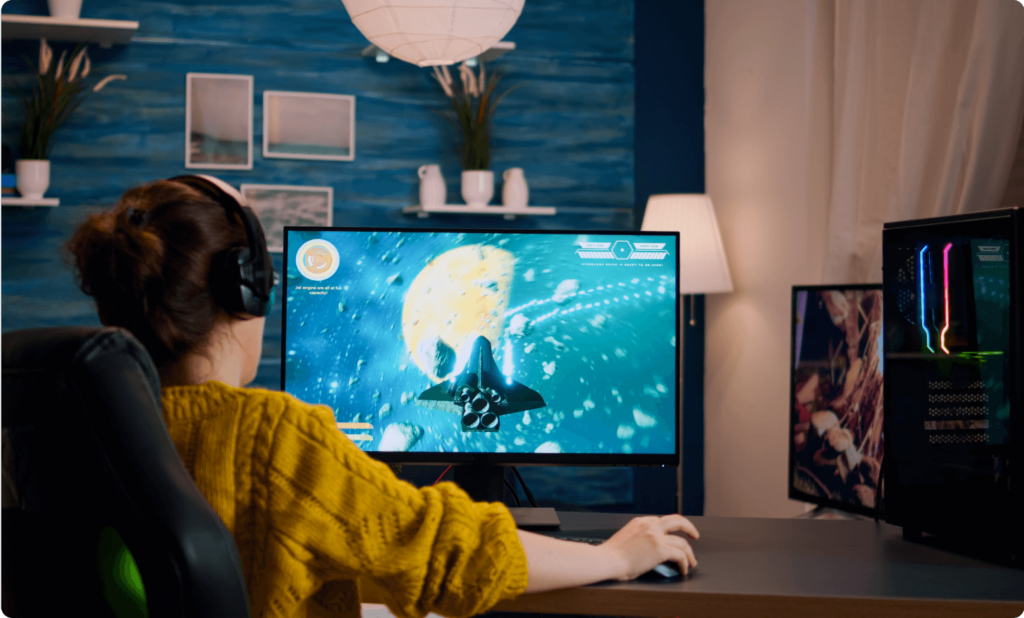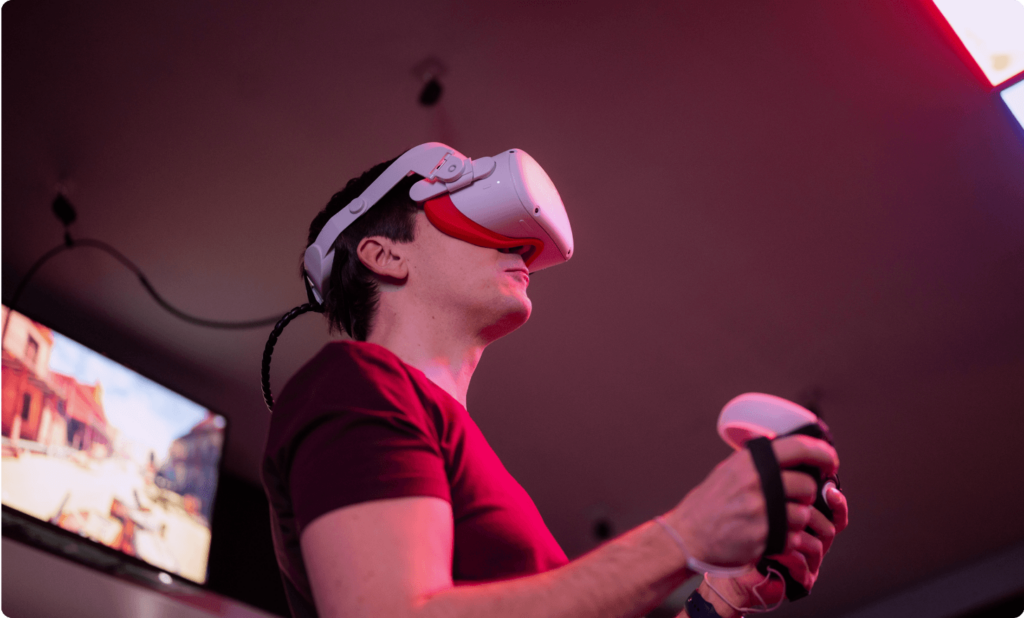Introduction
Hey there, fellow adventurers of the digital realm! Ever wondered how those epic video games you love are brought to life? Well, it’s time to uncover the magical world of 3D modeling for games!
Imagine it as a cosmic playground where 3D modeling for games is the superhero of creativity. Picture yourself whipping up mind-bending virtual reality sagas or boldly going where no one has gone before in augmented reality escapades. Yep, you guessed it – the art of 3D modeling is like having a magic wand to sculpt your wildest digital dreams into reality.
But hold on tight because our journey is just beginning! Gear up with your virtual swords and shields as we embark on an enthralling journey delving into the mesmerizing realm of 3D modeling for games.
Join us in uncovering the boundless potential of this captivating universe and discover how you can carve your path into this dynamic and ever-evolving industry. And guess what? We’ve got a super cool sidekick called 3D Viewer MAX, and it’s here to help us explore this exciting universe. So, gear up, and let’s embark on our quest!

What fuels the magic of 3D modeling in gaming?
3D modeling in the realm of gaming is nothing short of magic. It’s the wizardry that conjures lifelike characters, breathtaking environments, and awe-inspiring props from the depths of your imagination. It’s the art of breathing life into pixels, transforming lines and vertices into immersive worlds. But what fuels this magic?
Well, 3D modeling in gaming is like the VIP backstage pass to creating awesome three-dimensional digital stuff that fills up your screen. Think characters, objects, landscapes—the whole shebang—with depth, texture, and realism that makes you feel like you’re in the game, not just playing it. These are the puzzle pieces that build the epic gaming experience, where your imagination meets reality, or, you know, virtual reality.
Now, the coolest part? Game developers are like the rockstars of this magic show. They use 3D modeling to teleport you to crazy places like outer space, ancient kingdoms, or magical lands. They’re the architects of heroes, villains, and creatures that become the cool kids in pop culture. They design mind-blowing landscapes, from post-apocalyptic wastelands to enchanted forests. They craft models and unique characters, some relying on a visual reference, while others draw inspiration from many games within the gaming industry.
In their creative process, it’s as if they were casting magic spells to bring captivating concepts to life. It’s basically turning your coolest dreams into games you can actually play. Talk about leveling up your reality!

Enter 3D Viewer MAX: a portal to digital wonders
As we delve deeper into the enchanting world of 3D modeling, it’s only fitting to introduce you to 3D Viewer MAX, the key that unlocks the doors to digital wonders. This online tool is a game-changer, revolutionizing how you interact with 3D files in your browser. With 3D Viewer MAX, you can embark on a journey of discovery, inviting teammates and clients to explore your creations in real-time, online.
Whether you’re capturing the essence of your models in pictures or sharing them effortlessly via a simple link, this tool empowers you to breathe life into your creations and collaborate like never before.
From transforming simple shapes into immersive experiences to navigating hyper-realistic scenes in three dimensions, 3D Viewer MAX is the ultimate tool that turns 3D modeling for games into an unforgettable journey. Say farewell to long hours of frustration! With the arrival of 3D Viewer MAX, your 3D models are destined to shine like stars.
The quest for free 3D modeling: a hero’s journey
Now that we’ve set the stage for our adventure let’s embark on a quest to uncover the secrets of free 3D modeling. In a world where creative expression should know no bounds, it’s crucial to explore ways to create 3D models for games without breaking the bank. Picking the right software plays a pivotal role when embarking on the journey of crafting a design idea.
Embark on your game development journey with 3D Viewer MAX, an impressive software designed to empower aspiring game developers. This online platform provides a powerful set of 3D visualization and manipulation tools and fosters collaboration in a global environment. Imagine inviting talented individuals from around the world to help transform your creative visions into reality seamlessly.
3D Viewer MAX introduces you to a user-friendly, web-based 3D composing tool with an intuitive interface accessible through your browser, making it an invaluable resource for beginners.

Free 3D modeling DIY: crafting your destiny
As our quest continues, we uncover the ancient art of Free 3D Modeling DIY. This approach is about seizing the reins of destiny, crafting 3D models independently using plenty of resources and open-source tools. It’s about becoming the hero of your own creative saga.
Free 3D Modeling DIY is a testament to the human spirit of ingenuity and exploration. It’s the alchemy of turning software, online tutorials, the design process of a simple shape, and your own determination into tangible 3D and game assets. By embracing this path, you can unleash your creative potential and forge your unique mark on the gaming industry.
In a world that’s constantly evolving, why shouldn’t you evolve too? By turning the entire 3D modeling process into an opportunity to breathe life into your final product, you bid farewell to any steep learning curve that might threaten your enthusiasm.
The chronicles of modeling in video games
The art of video game modeling is as old as the industry itself. The narrative thread weaves together the visual tapestry of gaming worlds. It’s the craft of turning concepts into pixels and pixels into unforgettable experiences.
In the grand tapestry of video game development, modeling plays a role akin to that of a master storyteller. It defines virtual realms’ look, feel, and atmosphere, setting the stage for epic adventures and memorable escapades. Whether you’re diving into the gritty realism of next-gen consoles or casting spells in the fantastical worlds of Blizzard Entertainment, modeling is your canvas and the game engine is your magical tome.

Character modeling: the art of breathing life into pixels
Within the modeling world, character modeling is a realm of its own—a sacred art where artists mold digital clay into heroes and heroines, villains, and sidekicks. It’s the craft of breathing life into pixels, creating characters that players will cherish, empathize with, and root for.
Creating a character for a game is an intricate dance of artistry and technical finesse. It begins with a concept—an idea that captures the essence of the character’s personality, backstory, and role in the game. From there, artists journey through the realms of 3D modeling software, crafting the character’s physical form and imbuing it with details that resonate with players.
Rigging and animation follow, where the model is endowed with skeletal structures and movements that bring it to life. This stage plays a significant role in game modeling, allowing a character to emote, fight, and interact with the game world. Character modeling serves as the heart and soul of storytelling in gaming, where every expression, gesture, and action speaks volumes.
Becoming a 3D modeler for games: the hero’s path
Now that you’ve glimpsed the epic landscapes and intricate character journeys that await in the realm of 3D modeling, you might be wondering how you can embark on your own hero’s path. Becoming a 3D modeler for games is a quest that requires dedication, skill, and a burning passion for the craft.
In your heroic journey, 3D Viewer MAX is your trusted companion—a digital oracle granting you the power to easily view and share your 3D creations. It’s the bridge between your artistic visions and the digital realm, offering real-time collaboration and sharing capabilities that elevate your creative process.

Craft your portfolio
Begin by refining your skills in 3D modeling software. Unleash your creative energies and witness your mastery flourish. The goal is to transform the game ideas wandering in your mind into reality!
Your portfolio is your ultimate arsenal. Develop a diverse range of 3D assets—characters, objects, environments, and props. Demonstrate your versatility and artistic prowess.
Study game development and stay ever-vigilant
Immerse yourself in the world of game design. Understand the intricacies of level design, storytelling, and gameplay mechanics. This knowledge will breathe life into your models.
The gaming industry is a dynamic and ever-changing landscape. Keep your senses sharp and your knowledge up to date. Embrace technological advancements and adapt to new trends.
Network and collaborate
Forge alliances with fellow game developers, artists, and professionals. Attend conventions, participate in online communities, and share your work.
In the dynamic realm of game development, collaboration is sacred. Engage in team projects to master the art of communication and cooperation with designers, programmers, and fellow artists.
Build your online presence
Create a strong online presence through social media, portfolio websites, and online forums. Share your work, connect with the gaming community, and seek feedback to level up your skills.
The path of a 3D modeler is one of constant growth and evolution. Embrace a mindset of perpetual learning, adaptability, and resilience.
Modeling’s role in gaming: the weaving of realities
In the grand tapestry of gaming, modeling serves as the loom upon which realities are woven. It is a versatile art form that extends its influence across every facet of game development.
Game environments
Modeling breathes life into game environments, shaping landscapes, architecture, and ambiance. From sprawling cities to the tranquility of a forest glade, environments define the player’s journey.

Character drafting and sculpting
Characters embody the essence of gaming narratives. Through character modeling, they take on form, personality, and a captivating presence that resonates with players. It’s the art of crafting heroes, anti-heroes, and legends.
Inspiration is pivotal in the process of character modeling. Analyzing the characters of your favorite games delving into their characteristics and essential components, serves as a potent starting point. Then, quickly create a draft when inspiration strikes, infusing as much detail into that single model as possible.
Armed with modeling skills, character drafters breathe life into concept art, skillfully translating visual visions into digital avatars. Their mastery ensures that characters seamlessly align with the game’s aesthetic and narrative.
In this creative journey, each detail contributes to an immersive experience for players. Character sculpting, within the realm of gaming, goes beyond being an art; it’s a dynamic storytelling tool that invites players into rich, fantastical worlds where every hero and legend has a tale to tell.
Prop creation and procedural magic
Every object that populates the game world, from a rusty key to a majestic sword, is a creation of modeling. Props enhance immersion, provide tools, and become integral to gameplay.
Procedural modeling techniques conjure wonders through algorithms. They allow developers to easily generate complex structures and terrains, shaping entire worlds with the stroke of a virtual pen.

3D modeling impact in virtual reality games and the gaming industry
In the vast landscape of virtual reality (VR), modeling emerges as a transformative force, elevating user experiences to unprecedented levels. Creating intricate and lifelike 3D models transcends traditional gaming boundaries, ushering users into immersive landscapes and adventures that redefine the essence of being “inside” a game.
This journey extends beyond the virtual realm into augmented reality (AR) games, where the fusion of the real and digital worlds occurs seamlessly. AR games, propelled by 3D models, weave enchantment into everyday surroundings, transforming streets into dynamic battlegrounds and tabletops into arenas of adventure. The inherent versatility of 3D models makes this synthesis captivating and cost-effective, offering a powerful tool for creating magical overlays on the mundane.
Delving deeper, 3D modeling’s influence expands beyond mere aesthetics to the fundamental fabric of game mechanics. The geometry and rigging of 3D models play a pivotal role in shaping the gaming environment’s physics, collision detection, and animations. This integration of form and function is essential for delivering a seamless and engaging gaming experience.
The optimization of 3D models becomes crucial in maintaining a consistent frame rate and ensuring smooth gameplay. Reducing the polygon count and fine-tuning textures are crucial for real-time rendering—an entire process that demands meticulous attention to detail to meet the stringent requirements of modern gaming standards.
As the genesis of design, 3D modeling is the cornerstone for game developers. Designers utilize 3D models as visual anchors, allowing them to iterate and evolve their ideas. From conceptualizing characters to envisioning well-designed props, the versatility of 3D modeling is evident in every stage of game development.
In the intricate tapestry of gaming, 3D modeling is the warp and weft, the threads and colors, the canvas and brush. It shapes the worlds we explore and breathes life into the characters we befriend and the adventures we embark upon.
Whether in crafting a mood board, meeting a client’s requirements, or collaborating with an outsourced team, the language of 3D modeling speaks universally across many industries.

The chronicles of the game modelers: artistry and craft in the video game industry
Within the grand narrative of game development, game modelers emerge as the artisans and architects of virtual realities. Their craft blends artistry and technical expertise to create the building blocks of gaming experiences.
Game modelers are the silent narrators of the gaming world. They craft 3D assets that range from the humble street lamp to the grand citadel. They labor meticulously, ensuring that every polygon, texture, and animation aligns with the game’s vision.
But their role extends beyond craftsmanship. Game modelers are also the guardians of quality, the troubleshooters of technical issues, and the collaborators who bring visions to life. They are the unsung heroes behind the scenes, shaping the worlds that players explore.
In the world of game modelers, every model tells a story, and every story is a chapter in the grand adventure of game development. Their work is pivotal, their skills are revered, and their creations are etched into the collective memory of the gaming community.
Conclusion: your quest awaits
As we near the end of our journey through the captivating realm of 3D modelling for games, it’s clear that this art form is more than just a tool—it’s a portal to boundless creativity. With 3D Viewer MAX by your side, you can unlock the full potential of your creations, share them with the world in real-time, and collaborate seamlessly with fellow adventurers.
The quest to become a 3D modeler for games is an odyssey filled with challenges, learning, and rewards. It’s a path where artistry meets technology, and imagination becomes reality. Whether you’re forging characters, sculpting environments, or crafting props, your journey as a game modeler is a voyage into uncharted territories of creativity.
So, gather your tools, sharpen your skills, and embark on this epic quest. The gaming industry awaits your talents, and the digital worlds you create will be the playgrounds of future generations of gamers. Your quest as a 3D modeler is about to begin, and it promises a lifetime of adventures, challenges, and magic.






